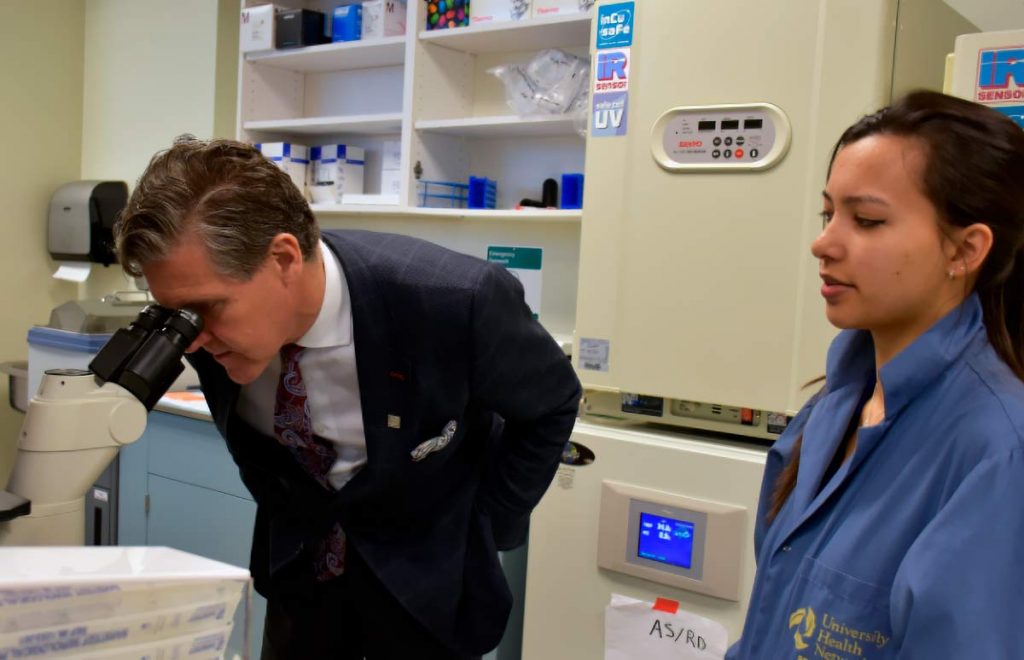The Fehlings Lab, housed within the Krembil Discovery Tower at the University of Toronto, established itself as a leading research facility in the field of neural repair and regeneration. With a focus on spinal cord injuries, spinal cord diseases, and related neurological disorders, this lab made solid contributions before its closure. Despite no longer operating, the Fehlings Lab’s impact remains profound and far-reaching.

Fehlings Lab Overview
Tracing its origins to the seminal work of Dr. Tator and Dr. Fehlings on the secondary phase of spinal cord injury, the lab evolved into a world-class research hub. It boasted state-of-the-art facilities and a diverse team of highly skilled scientists with expertise spanning surgery, pathology, genetics, cell and molecular biology, and electrophysiology.
- Modern Facilities: Located in the Krembil Discovery Tower, the lab was equipped with the latest technologies enabling advanced research and development in neural repair.
- Multidisciplinary Team: The team included specialists in various fields, contributing a broad spectrum of expertise necessary for detailed research in neural regeneration.
The primary research areas were spinal cord injury, cervical spondylotic myelopathy, and cerebral palsy. Utilizing powerful resources and extensive expertise in generating and characterizing animal models, the researchers conducted studies on various aspects of these traumatic and degenerative neuropathies.

From Medicine to Gambling: Cross-Field Impact of Labs
Research labs like the Fehlings Lab are pivotal in bridging scientific knowledge across diverse fields, including medicine and the online casino industry. In medicine, their work advances our understanding of neural disorders and potential treatments, while in the gambling sector, insights into human cognition and behaviour can lead to more responsible gaming strategies and enhanced user experiences. These findings can help the best online casinos, included in this Full List of Canadian Options, design better user interfaces, implement effective self-regulation tools, and create more engaging and safer gaming environments.
Who Was Behind the Fehlings Lab?
At the helm of this lab was Dr. Michael Fehlings, a distinguished neurosurgeon and researcher renowned for his contributions to the field. Dr. Fehlings seamlessly combined an active clinical practice in complex spinal surgery with a translational research program focused on discovering novel treatments for injuries to the brain and spinal cord.
The lab’s team comprised a multidisciplinary group of researchers, including postdoctoral fellows, PhD candidates, research associates, and technicians. Each member brought unique expertise, and their collaborative efforts led to numerous publications and prestigious awards.
Notable team members included Dr. Sukhvinder Kalsi-Ryan, a licensed physical therapist and researcher specializing in outcome measurement and upper limb recovery in tetraplegia, as well as Ahad Siddiqui, a postdoctoral fellow investigating cellular and molecular mechanisms of spinal cord injury.
Major Events and Symposia
One of the lab’s flagship initiatives was the annual Tator-Turnbull Symposium, a platform for leading researchers in the field of spinal cord injury to present their findings. This symposium facilitated knowledge exchange, fostered collaboration, and played a crucial role in shaping the discourse within the spinal cord injury research community.
Past symposia featured esteemed speakers such as Dr. Ole Kiehn from the Karolinska Institute, Dr. Susan Harkema from the University of Louisville, and Dr. Armin Curt from the University of Zurich, among others.
Year | Speakers |
2014 | Dr. Ole Kiehn, Karolinska Institute |
2013 | Drs. Derek van der Kooy, Cindi Morshead, and Andras Nagy, University of Toronto |
2012 | Dr. Susan Harkema, University of Louisville |
2011 | Dr. Armin Curt, University of Zurich |
2010 | Dr. V. Reggie Edgerton, Brain Research Institute, UCLA |
2009 | Dr. James Fawcett, Cambridge University Centre for Brain Repair, United Kingdom |
2008 | Dr. Jerry Silver, Case Western Reserve University, Cleveland, OH |
2007 | Dr. Serge Rossignol, University of Montreal |
2006 | Dr. Arthur Prochazka, University of Alberta |
2005 | Dr. John Steeves, International Collaboration On Repair Discoveries (ICORD), Vancouver, BC |
Research and Projects
The Fehlings Lab’s research portfolio was diverse and comprehensive, encompassing various themes and projects aimed at pushing the boundaries of what was possible in neural repair and regeneration.
One significant area of focus was investigating the application of stem cells, nanotechnology, and tissue engineering strategies for spinal cord repair and regeneration. The lab’s work in this area sought to develop innovative approaches to promote regeneration and functional recovery.
Additionally, the lab explored the potential of pharmacological interventions, including compounds approved for other disorders, such as riluzole, for their therapeutic effects in spinal cord injury. This approach held promise for accelerating the translation of research findings into clinical applications, as these substances had already undergone rigorous safety testing.
The lab’s commitment to translational research was evident in its involvement in multiple clinical trials, including the Efficacy of Riluzole in Surgical Treatment for Cervical Spondylotic Myelopathy (CSM-Protect) trial and the Riluzole in Spinal Cord Injury Study (RISCIS). These trials allowed for the testing of new therapeutics and treatment strategies directly with patients, bringing the lab’s research closer to clinical implementation.
Where Are They Now: The Lab’s Impact on the Field
While the Fehlings Lab has closed, its legacy continues to shape the field of neural repair and regeneration in profound ways. The groundbreaking research conducted within its walls has influenced medical research and treatment strategies worldwide.
Currently, Dr. Michael Fehlings holds several important positions that show he is still a leader in neurosurgery and spinal cord injury research. As the Vice Chair of Research in the Surgery Department at the University of Toronto, he helps guide the university’s research work and creates an environment for new discoveries. He also serves as the Robert Campeau Foundation/Dr. C.H. Tator Chair in Brain and Spinal Cord Research at the University Health Network. In this role, he leads cutting-edge research projects and works with other respected researchers to find new treatments and therapies.
Dr. Fehlings’ expertise is further strengthened by his roles as a Scientist at the McEwen Centre for Regenerative Medicine, a McLaughlin Scholar in Molecular Medicine, and the Co-Director of the University of Toronto Spine Program. These varied responsibilities ensure he remains at the forefront of scientific progress, using his extensive knowledge and experience to advance areas like regenerative medicine, molecular research, and spinal cord injury treatment.
Many of the lab’s former team members have gone on to pursue their own research endeavours, building upon the foundations laid by their work at the Fehlings Lab. They have carried forward the lab’s methodologies and approaches, driving progress in the understanding of neural repair and regeneration.
The lab’s commitment to interdisciplinary collaboration and translational research has set a precedent for future scientific endeavours in this field, encouraging researchers and clinicians to work together to bridge the gap between bench and bedside.
Fehlings Lab’s Contributions to Neural Repair
The Fehlings Lab’s contributions to the field of neural repair and regeneration are profound and enduring. Through its pioneering research, state-of-the-art facilities, and dedication to translating discoveries into clinical applications, this remarkable laboratory has left an indelible mark.
As research in this field progresses, the influence of the Fehlings Lab’s work and methodologies will continue to guide efforts to develop effective treatments and therapies for those affected by spinal cord injuries, spinal cord diseases, and related neurological disorders.
The lab’s closure marks the end of an era, but its impact will resonate for generations to come, inspiring researchers and clinicians to continue pushing the boundaries of what is possible in the pursuit of healing and hope for individuals affected by these debilitating conditions.
